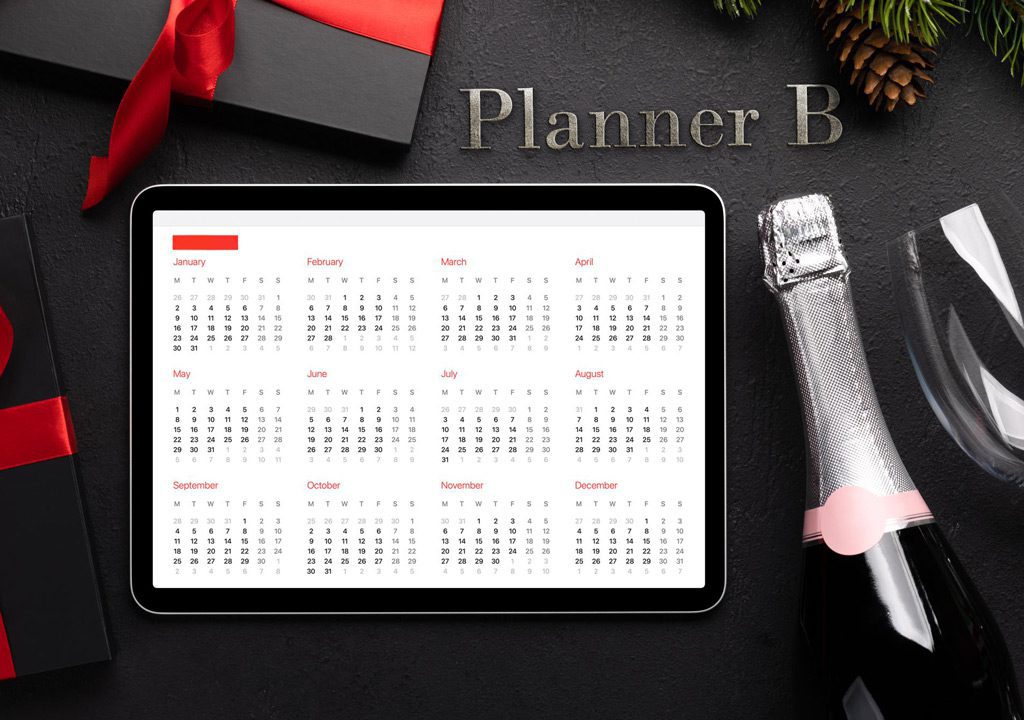Blog
Annual Planning: a Way to Boost Productivity and Achieve Success

Have you ever paused to consider why our goals sometimes slip away or completely disappear? Picture this: even with a clear destination in mind and all the preparation in the world, aimlessly rushing forward rarely leads to success. This reality presents us with a profound challenge on our journey to success.
While it's true that each attempt brings valuable lessons, one must question whether enough effort, focus, and dedication were truly invested. And if not, what stopped us from or what distracted us from giving our all?
From experience, I've noticed that people often lose sight of their main goals amidst the daily responsibilities and distractions. While the goals stay the same, we often find ourselves drifting from the intended path. However, this deviation isn't entirely our fault. If a goal holds significant importance and is correctly set, there's a method to remedy this pattern of misdirection.
Breaking down the journey into manageable steps and steadfastly committing to them until the end can pave the way for success. And when it comes to aiding this commitment, there's nothing quite as effective as a well-crafted annual planner tailored to your needs and goals, diligently followed.
Regardless of whether you choose a traditional paper planner or a digital Planner, what matters most is what's inside and how committed you are to it. In the upcoming sections, together we'll explore the essential elements to include in your planner, ensuring it becomes a valuable tool in reaching your goals.
Whether you're a budding entrepreneur, a business owner, or an ambitious professional, effective annual planning is a game-changer. It lays the foundation for success, helping you set goals, make informed decisions, and stay on track throughout the year.
With expert insights and proven techniques, we'll walk you through the entire process, from goal setting and SWOT analysis to budgeting and resource allocation. in this article on planner b We'll explore best practices, case studies, and practical tips that will empower you to create a comprehensive and actionable annual plan that aligns with your objectives.
The Importance of Annual Planning
Annual planning is the cornerstone of success. It provides a roadmap for achieving your goals, ensuring you stay focused, organized, and on track throughout the year. By taking the time to plan ahead, you gain clarity on your objectives, identify potential obstacles, and chart a course for success.
One of the key benefits of annual planning is that it helps you set clear goals and objectives. Without a plan in place, it's easy to get lost in the day-to-day activities and lose sight of the bigger picture. By defining your goals for the year, you create a sense of purpose and direction, giving your actions meaning and significance.
Annual planning also allows you to make informed decisions. By conducting a thorough analysis of your strengths, weaknesses, opportunities, and threats (SWOT analysis), you gain a deeper understanding of your business or career. This knowledge helps you identify areas for improvement, capitalize on opportunities, and mitigate risks.
Additionally, annual planning provides a framework for resource allocation and budgeting. By carefully considering your priorities and resources, you can allocate your time, money, and energy more efficiently. This ensures that you're investing your resources in the areas that will yield the greatest return, maximizing your productivity and driving results.
In summary, annual planning is essential for achieving success. It enables you to set goals, make informed decisions, allocate resources effectively, and stay focused on what matters most. Now, let's dive into the key components of an annual planning process.
Key Components of an Annual Planning Process
An effective annual planning process consists of several key components that work together to create a comprehensive and actionable plan. Let's explore each of these components in detail:
Setting Goals and Objectives for the Year
The first step in the annual planning process is to set clear and specific goals and objectives for the year. These goals should be aligned with your long-term vision and mission, providing a roadmap for success. When setting goals, it's important to make them SMART (Specific, Measurable, Achievable, Relevant, and Time-Bound). This ensures that your goals are clear, measurable, and realistic.
To set effective goals, start by reflecting on your long-term vision. What do you want to achieve in the next year? Break down your vision into specific objectives that are achievable within the given timeframe. For example, if your vision is to increase revenue by 20%, your objectives could be to launch a new product, expand into new markets, or improve customer retention.
Once you have identified your objectives, break them down into smaller, actionable steps. This will help you create a clear plan of action and make progress towards your goals throughout the year. Remember to assign responsibilities and set deadlines for each step to ensure accountability and keep yourself on track.
Conducting a SWOT Analysis
A SWOT analysis is a powerful tool that helps you assess your strengths, weaknesses, opportunities, and threats. It provides a holistic view of your business or career, enabling you to identify areas for improvement and capitalize on opportunities. By understanding your strengths and weaknesses, you can leverage your strengths and address your weaknesses to gain a competitive edge. Similarly, by identifying opportunities and threats, you can seize opportunities and mitigate risks.
To conduct a SWOT analysis, start by evaluating your strengths. What are your unique strengths and competitive advantages? These could include factors such as your expertise, reputation, or unique product offerings. Next, assess your weaknesses. What areas do you need to improve? These could include factors such as lack of resources, outdated technology, or poor customer service.
After evaluating your strengths and weaknesses, turn your attention to opportunities. What external factors could positively impact your business or career? These could include factors such as emerging markets, new technologies, or changes in consumer behavior. Finally, consider the threats that could potentially hinder your progress. These could include factors such as increased competition, economic downturns, or regulatory changes.
By conducting a thorough SWOT analysis, you gain valuable insights that will inform your annual plan. These insights will help you identify strategic priorities, allocate resources effectively, and make informed decisions throughout the year. Now that you have a clear understanding of your goals and have conducted a SWOT analysis, it's time to create an action plan.
Creating an Action Plan

An action plan is a detailed roadmap that outlines the specific steps and activities required to achieve your goals. It breaks down your objectives into actionable tasks, providing a clear plan of action for the year. When creating an action plan, it's important to be specific, realistic, and aligned with your overall goals and objectives.
Start by breaking down each objective into smaller, manageable tasks. Assign responsibilities to team members or yourself, and set deadlines for each task. This ensures that everyone is clear about their roles and responsibilities and helps you track progress throughout the year.
When creating your action plan, consider the resources and budget required for each task. This will help you allocate your resources effectively and ensure that you have the necessary funds and support to execute your plan. It's also important to consider any potential obstacles or risks that could impact your plan and develop contingency plans to mitigate them.
Remember, an action plan is a living document that should be reviewed and updated regularly. As circumstances change throughout the year, you may need to adjust your plan to stay on track. By regularly reviewing and updating your action plan, you ensure that it remains relevant and aligned with your goals.
Allocating Resources and Budgeting
At times, achieving our goals requires assistance from others, prompting the need for strategic resource allocation. In such instances, effective planning is essential to maximize the utilization of resources. A key component of annual planning involves allocating resources and budgeting to ensure optimal outcomes. Without proper resource allocation, it's challenging to achieve your goals effectively. In this section, we will dive into the key considerations and strategies for allocating resources and creating a budget that supports your annual plan.
1. Assess Your Needs and Priorities
Before diving into resource allocation and budgeting, it's essential to assess your needs and priorities. Understand the goals you want to achieve in the coming year and identify the resources required to accomplish them. Consider factors such as manpower, technology, infrastructure, and marketing initiatives. By identifying your needs and priorities, you can allocate resources more efficiently.
2. Evaluate Available Resources
Once you have a clear understanding of your needs, evaluate the resources available to you. Take stock of your existing resources, including finances, human capital, and equipment. Assess their strengths, weaknesses, and limitations. This evaluation will help you determine if you need to acquire additional resources or optimize existing ones to align with your annual plan.
3. Create a Realistic Budget
Based on your needs assessment and resource evaluation, it's time to create a realistic budget. Set financial targets and allocate funds to different areas of your annual plan. Consider factors such as operational expenses, marketing and advertising costs, research and development investments, and contingency funds. A well-planned budget will ensure that you have the necessary financial resources to execute your annual plan effectively.
Allocating resources and creating a budget are integral parts of annual planning. By assessing your needs, evaluating available resources, and creating a realistic budget, you can optimize resource allocation and set yourself up for success.
Implementing and Monitoring Progress
Once you have crafted your annual plan and allocated resources, the next step is to implement it effectively. In this section, we will explore strategies for implementing your annual plan and monitoring progress to ensure you stay on track and achieve your goals.
1. Break Down Goals into Actionable Steps
To effectively implement your annual plan, break down your goals into actionable steps. Identify key milestones and create a timeline for each objective. Assign responsibilities to team members, ensuring clarity and accountability. Breaking down goals into smaller steps makes them more manageable and allows you to track progress effectively.
2. Establish Key Performance Indicators (KPIs)
To monitor progress and measure success, establish key performance indicators (KPIs) for each goal or objective in your annual plan. KPIs provide quantifiable metrics that allow you to gauge progress and make data-driven decisions. Ensure your KPIs are specific, measurable, attainable, relevant, and time-bound (SMART). Regularly track and review your KPIs to stay on top of your progress.
3. Regularly Review and Adjust
Annual planning is not a one-time event; it requires regular review and adjustment. Set aside time to review your progress against your annual plan. Identify any gaps or areas that need improvement. Be open to making adjustments and pivoting your strategies as needed. Regular reviews help you stay agile and ensure that your annual plan remains aligned with changing circumstances.
Implementing your annual plan and monitoring progress are vital to ensure that you stay on course and achieve your desired outcomes. By breaking down goals into actionable steps, establishing key performance indicators, and regularly reviewing and adjusting your strategies, you can maximize your chances of success.
Conclusion
In conclusion, annual planning is a powerful tool that can drive success and productivity. By setting clear goals, allocating resources effectively, and implementing strategies with precision, you can elevate your performance and achieve remarkable results.
Remember, annual planning is not a one-size-fits-all approach. Tailor your planning process to your unique circumstances and objectives. Leverage the insights and strategies shared in this guide to create a comprehensive and actionable annual plan that aligns with your vision for success.
Embrace the power of annual planning, envision your future, strategize your actions, and watch your dreams become realities. Take the first step today and unlock your full potential for success. Start mastering the art of annual planning and witness the transformative impact it can have on your personal and professional growth.
